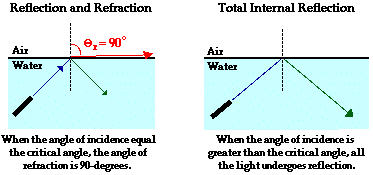In this chapter, we learnt about light and how it reflects and refracts, as well as its behaviour in mirrors. It is defintely very interesting. So here goes:
Firstly, What is light? Light is the form of energy which enters our eyes and enables us to see.
Reflection
When a ray of light strikes a surface, it changes its direction of travel by following the laws of reflection. These are the terms used in relfection when a ray of light strikes a plane mirror:
-Incident ray: the ray of light that strikes the surface.
-Reflected ray: the ray of light that is reflected off the surface.
-Normal: an imaginary line that is perpendicular to the surface at the point of incidence.
-O the point of incidence: the point where the incident ray strikes the surface.
-i, angle of incidence: angle between the incident ray and the normal.
-r, angle of reflection: angle between the reflected ray and the normal.
There are two laws of reflection, namely:
1. The incident ray, the reflected ray and the normal at the point of incidence all lie in the same plane.
2. The angle of incidence is equal to the angle of reflection.
Mirrors
Now we move on to mirrors. We learn about the characteristics of the image formed in a plan mirror. It:
1.Has the same size as the object
2.Is as far behind the mirror as the object is in front of the mirror
3.Has the same orientation as the object
4.Is laterally inverted
5.Is Virtual.
Refraction
When light strikes a opaque relflecting surface, light is partially reflected off the surface and partially transmitted through the medium. The reflected light follows the laws of reflection. However, the light that is transmitted I talked about earlier. It bends as it travels from one optical medium into another. The bending effect of light is known as refraction!
The critical angle is the angle of incidence in the optically denser medium when the angle of refraction in the optically less dense medium is 90 degrees.
Total internal reflection occurs when the incident ray s in the optically denser medium, and the angle of incidence is greater than the critical angle. All light is reflected within the glass itself!
We also learnt about Snell's law, which calculates the refractive index. It relates the angles of incidence and refraction!
Reflections:
I feel that this was a very difficult topic for me. I had to memorize the various terms and the drawing part was very tricky as there were many things to be drawn. However, it was rather straightforward and by looking through the notes over and over again, I did manage to understand the topic better.


No comments:
Post a Comment